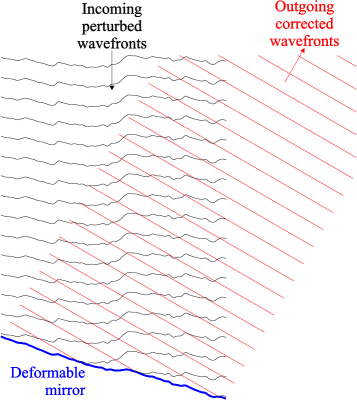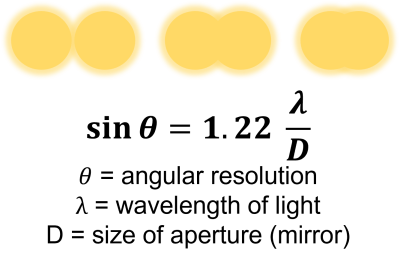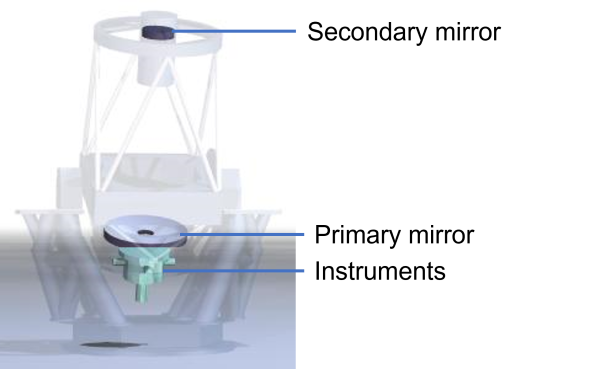Telescopes Glossary

Credit: WikiCommons
Adaptive Optics: This is the technique used on telescopes to change the shape of the mirror to make up for the changes in the atmosphere. A wave sensor is placed in the path of light coming from a star. The stars picked for this are bright stars nearby in the sky to the objects we want to observe. The object you want to look at is called the science target, but these are often very faint. The bright star's light passes through the wave sensor which finds changes in the light from the straight-line wavefronts you'd expect to see in space. These changes are due to the weather and atmosphere. If the seeing is poor then the wavefront will be more bumpy. The information from the wave sensor is then passed to the deformable mirror - the mirror changes its surface to match the wavefront of the light from the star. Then the light which is reflected into the instruments is close to a flat shape again. This means more light and more information from the signal.
Active optics: This is another way for the shape of a telescope mirror to be changed. It is done by moving small pistons on the back of the mirror called actuators. The aim is to keep the mirror perfectly aligned so that as much of the light as possible is reflected onto the instruments. This is needed for large mirrors such as the 10-metre ones of the Keck Telescopes. These mirrors are so big that they can start to sag without this support. They can also change shape if it is windy, or the temperature changes. These systems keep the mirrors in the right shape.
Detector: The bits within the telescope instruments which actually 'see' the light. They can measure how much light there is or the direction of the light. They can even see the different wavelengths of light depending on what instrument is being used. In most telescope cameras, these detectors will be CCDs but there can be other types too.

The Rayleigh Criterion is shown and defined.
Credit: The Schools' Observatory
First light: This is the name given to the first time a newly built telescope gets to observe the night sky. This will happen after the whole telescope has been constructed and the instruments have been added. Before this point lots of tests will have been carried out to check everything is working OK.
Resolution: For a telescope, this means how close 2 objects can be in the sky before the telescope can only see one big blob. For example, a planet moving close to its parent star. This distance will change depending on how big the telescope is, and what wavelength of light it is looking in. We use the Rayleigh Criterion to work this out in astronomy.
Instrument: This is the name we give to each machine attached to a telescope to take measurements. The most common would be a camera measuring the amount of light coming from space. You can also have machines which measure the types of light and many others. The telescope is designed to get as much light as possible into these machines so that they can take measurements and science can be done with the data!

position of the primary and secondary mirrors along with
the telescope instrumentation.
Credit: The Schools' Observatory
Primary mirror: This is the biggest mirror on the telescope and the one which collects all the light. The bigger the mirror the more light it can collect. This also means that it can see fainter objects, and objects which are further away. Modern primary mirrors can either be single dishes (known as monolithic) or sets of mirrors. These sets all line up together to make one big mirror - called segmented mirrors.
Secondary mirror: This is the second mirror that light will reach when it enters a telescope. It collects the light reflected from the primary mirror and sits at the top of the telescope. Its job is to move the light into the instruments. On the Liverpool Telescope, this mirror sends the light back down through a hole in the centre of the main mirror to where all the instruments are.

